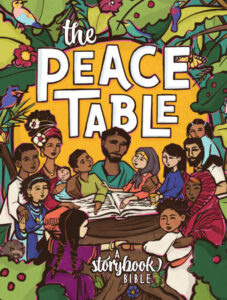This article is part of our series on The Peace Table , the new storybook Bible from Shine, a children’s Sunday school curriculum, jointly published by MennoMedia and Brethren Press
 Chrissie Muecke has a master’s degree in elementary teaching and curriculum from the University of Rochester and is pursuing a Master of Arts in Christian leadership from Eastern Mennonite Seminary. She has worked for MennoMedia and Brethren Press as a curriculum writer and editor for 14 years. Chrissie co-authored three Bible storybooks, titled “All of Us,” “All Together” and “Great Big Love.” She attends Rochester (New York) Mennonite Fellowship.
Chrissie Muecke has a master’s degree in elementary teaching and curriculum from the University of Rochester and is pursuing a Master of Arts in Christian leadership from Eastern Mennonite Seminary. She has worked for MennoMedia and Brethren Press as a curriculum writer and editor for 14 years. Chrissie co-authored three Bible storybooks, titled “All of Us,” “All Together” and “Great Big Love.” She attends Rochester (New York) Mennonite Fellowship.
_____________________________________________________________________________
From the time I was very young, I wanted to write a children’s book. I spent many hours coming up with characters and interesting plotlines. I carefully wrote each story using my best cursive, stapled a construction paper cover on the outside, then added a title and cover illustration.
This love of story continued into college, when I took a children’s literature course. Our final assignment was to create a children’s book, start to finish. This included writing, illustrating, creating a cover and binding the book by hand. The absence of computers and the use of colored pencils and tape didn’t result in the most professional-looking book, but I loved the whole process.
I am now the curriculum editor for “Shine: Living in God’s Light,” a children’s Sunday school curriculum, jointly published by MennoMedia and Brethren Press. For the past 18 months, I have had the incredible privilege of overseeing the creation of The Peace Table: A Storybook Bible. I got to make a book “for real” this time!
There are many questions to consider when creating a book for children — far more than I had ever realized as a child or college student. This is particularly true for a book of Bible stories.
There are questions about content: Which Bible stories do we choose, which do we leave out and what impact does that have on children’s faith development? How do we order the stories to help children understand the big picture of the biblical story? Who gets to write the stories, and how does that influence the message?
There are theological questions: Which beliefs and values do we call attention to in the Bible stories, questions and additional content? The church is divided on many issues. How do we care for families across the theological spectrum? How do we handle difficult stories that condone violence, show a vengeful God or are likely to frighten children?
There are illustration questions. How do we depict each Bible story? Who decides how the characters are shown? What messages are conveyed, both directly and indirectly, through the choices we make about the illustrations?
And don’t forget the more mundane questions: What should the word count be for each story? How many pages? What type of paper? Which cover style? Which font? What size?
The Shine team and a variety of consultants worked together to answer these questions about The Peace Table, honing our answers even up until the day it went to the printer! We did not, however, approach this book as merely a set of questions to be answered.
Creating a storybook Bible for children is a holy calling requiring much prayer, theological reflection, humility, wisdom, creativity and imagination.
Our desire is to offer up a vision of the whole people of God, in all our diversity and complexity. We want children to feel at home among the Bible stories — to see themselves and their experiences reflected in how the stories are told and depicted. We want to care for the needs of all families, providing space for families to wonder, share and discuss their own beliefs and values in response to the Bible stories. We want to help children discover that the Bible is more than just entertaining stories and encourage interactive spiritual practices that will sustain children throughout their lives.
Here are a few examples of how we attempted to express this vision:
- We included the full range of content that is in the Bible — history, law, poetry, prophecy, gospels, epistles, wisdom literature, even Song of Songs! This breadth helps children see that we can come to the Bible for many reasons, beyond just entertainment. Prophecies show the unique ways that God communicated with people over time. Psalms offer comfort and give voice to some of our difficult questions and strong emotions. The epistles provide a window into the joys and challenges of life in the early church.
- We hired a diverse group of illustrators and invited them to illustrate the Bible stories from their own cultural background and heritage. This resulted in a beautiful array of characters and settings. Illustrators were also encouraged to include children in the art, even when children were not specifically named in the biblical text. This helps readers imagine themselves as part of the story and serves as a reminder of how much children matter to God.
- Open-ended conversation prompts allow families to highlight situations and people whose values and beliefs align with their own. Rather than naming a specific person to emulate, one prompt says, “Share a story of someone who spoke up and told the truth even when it was hard.” Families will answer this differently, depending on their theological understandings.
- Broad prayer suggestions, rather than scripted prayers, allow families to emphasize the topics, people and concerns that are relevant for them. Rather than saying, “These are the words you should pray,” we provide suggestions for a topic and/or a way to pray. For example: “Pray for a difficult situation in your community,” or, “Draw a picture to show your prayer.”
Co-writing and editing The Peace Table was a dream come true for me. It was far beyond what my eight-year-old self could have ever imagined. The opportunity to work collaboratively with two other writers, seven consultants, thirty illustrators, an incredible designer, copy editors and proofers was such a joy. Each person brought their wisdom and creativity to the project. Together, we offer The Peace Table: A Storybook Bible as a gift, praying that it will nurture and inspire children, families and churches, as they seek to love Jesus, grow in faith and become peacemakers who change the world.
For more information on The Peace Table, visit www.thepeacetablebible.com.
The views and opinions expressed in this blog belong to the author and are not intended to represent the views of the MC USA Executive Board or staff.
Interested in submitting a blog for Menno Snapshots? Please see our blog guidelines here.


